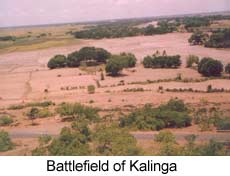

 |  |
 When Ashoka, the son of the Mauryan emperor Bindusara and the grandson of Chandragupta Maurya, ascended the throne of Magadha in 273 B.C. treading in the footsteps of his forefathers he set out to expand his empire. In the 12th year of his reign, he sent a message to Kalinga asking its submission, but the Kalingaraj refused to submit to the Mauryan empire.
When Ashoka, the son of the Mauryan emperor Bindusara and the grandson of Chandragupta Maurya, ascended the throne of Magadha in 273 B.C. treading in the footsteps of his forefathers he set out to expand his empire. In the 12th year of his reign, he sent a message to Kalinga asking its submission, but the Kalingaraj refused to submit to the Mauryan empire.As a result Ashoka lead a huge army against Kalinga. This took place in 261 B.C., the freedom loving people of Kalinga offered a stiff resistance to the Mauryan army. The whole of Kalinga turned into a battle arena. History offers us but few examples of such fiercely fought wars as this. The Kalingaraj himself commanded his army in the battle field. However, the limited forces of Kalinga were no match for the overwhelming Magadha army. Contrary to Ashoka's expectations, the people of Kalinga fought with such great valor that on number of occasions they came very close to a victory. The soldiers of Kalinga perished in the battlefield fighting till their last breath for their independence. The victory ultimately rested with Ashoka. The war took a tremendous toll of life and property. The 13th rock edict of Ashoka throws light on this war. Atleast 0.1 million Kalingans were killed while another 0.15 million were taken prisoners. And almost equal number of Magadha soldiers were also killed. There was not a single man left in Kalinga to live a life of slavery. This is the singular instance of a war in history which brought about a complete change of heart in a stern ruler like Ashoka. The scene of the war presented a horrible sight, the whole terrain was covered with the corpses of soldiers, wounded soldiers groaned in severe pain, vultures hovered over their dead bodies, orphaned children mourning the loss of their nears and dears, widows looked blank and despaired. This sight overwhelmed Ashoka. He realized that his victory at such a cost is not worthwhile. The whole war resulted in Ashoka's deviation towards Buddhism and after two and a half years he became an ardent follower of Buddhism under Acharya Upgupta. next page >> |
Copyright ©2000 indiansaga.info. All rights reserved.
By using this service, you accept that you won't copy or use the data given in this website for any commercial purpose.
The material on indiansaga.info is for informational & educational purpose only.
This site is best viewed at 800 X 600 picture resolution.